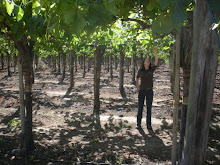 This weekend was Tim’s Rib King Cook Off at Tim’s Special Cut Meats in Coeur d’Alene. They were short a couple judges, so my dad and I stepped up to the plate and volunteered to sit on a panel of 15 professional and not-so-professional barbecue critics. We were on the less professional side of things, as we have not gone through the Pacific Northwest Barbecue Association’s judging class.
This weekend was Tim’s Rib King Cook Off at Tim’s Special Cut Meats in Coeur d’Alene. They were short a couple judges, so my dad and I stepped up to the plate and volunteered to sit on a panel of 15 professional and not-so-professional barbecue critics. We were on the less professional side of things, as we have not gone through the Pacific Northwest Barbecue Association’s judging class.At these three-tiered judging classes, one learns the finer points of Beef Brisket, Chicken, and Pork Ribs/Shoulder. The first class is a general judging certification, followed by the Pitmaster Judge certification, then finally the Grand Master Judge cert. In these classes, aspiring judges learn about cuts of meat, wood selection, sauces, spices, rubs, BBQ equipment and theory. Judging criteria, food prep standards, presentation, disqualifications, general rules, procedures and regulations are gone over in detail, all while eating large quantities of meat!But, I have yet to go through this grilling guru training, so I needed a crash course in rib knowledge.
Pork Rib Basics
The PNWBA uses a 1
 0-point judging system that judges meats on appearance, texture/tenderness, and taste (25%, 25%, 50%). There are two types of pork ribs: Spare Ribs and Baby Back Ribs. The differences in these cuts are seemingly insignificant, but it makes all of the difference in the flavor, texture, and appearance.Baby Back Ribs are cut from the loin section- the place where pork chops come from. In grocery stores, baby backs may also be labeled “loin back ribs” or “back ribs.” Baby backs are smaller, less fatty, and naturally more tender than spare ribs, which also means they take less time to cook. They’re the most popular rib, partly because they’re neat, compact and easy to eat. They are practically dainty compared to spare ribs and must weight 1.75 lbs. or less for an entire rack.
0-point judging system that judges meats on appearance, texture/tenderness, and taste (25%, 25%, 50%). There are two types of pork ribs: Spare Ribs and Baby Back Ribs. The differences in these cuts are seemingly insignificant, but it makes all of the difference in the flavor, texture, and appearance.Baby Back Ribs are cut from the loin section- the place where pork chops come from. In grocery stores, baby backs may also be labeled “loin back ribs” or “back ribs.” Baby backs are smaller, less fatty, and naturally more tender than spare ribs, which also means they take less time to cook. They’re the most popular rib, partly because they’re neat, compact and easy to eat. They are practically dainty compared to spare ribs and must weight 1.75 lbs. or less for an entire rack.Spare ribs, sometimes called side ribs, are a cut taken from the belly side of the pig's rib cage above the sternum and below the back ribs, which is also where bacon is cut. Spare ribs are flatter than the curved back ribs and are bigger, tougher, and contain more meat, fat and bone than BBR’s. Because they are a larger cut, they traditionally take longer to cook. Most grocery stores sell Spare Ribs “St. Louis Style,” meaning that the rib tips are removed.
 The contestants started their grills first thing in the morning and hung out all day while their ribs smoked to perfection. I asked a couple different contestants for their recipes and was politely declined by most and got one, resounding “No way, Jose!” Turns out that that these rib recipes are jealously guarded family secrets, not to be shared with a mere food writer/judge.
The contestants started their grills first thing in the morning and hung out all day while their ribs smoked to perfection. I asked a couple different contestants for their recipes and was politely declined by most and got one, resounding “No way, Jose!” Turns out that that these rib recipes are jealously guarded family secrets, not to be shared with a mere food writer/judge.
We ate our way through sixteen spare and sixteen baby back rib entries without the aid of so much as a beer. Yes, that’s right. Judges are only allowed to have saltine crackers and water to clear the pallet. The PNWBA can expect a strongly-worded letter from me chastising their beverage availability and espousing the virtues of a good brew paired with ribs.
After all the score sheets were turned in and the votes tallied, George Pitts of the Pitts Place BBQ, was named Rib King!
Check out this website for more info about judging classes and criteria!
www.pnwba.com
Welcome to your weekend! -KB




No comments:
Post a Comment